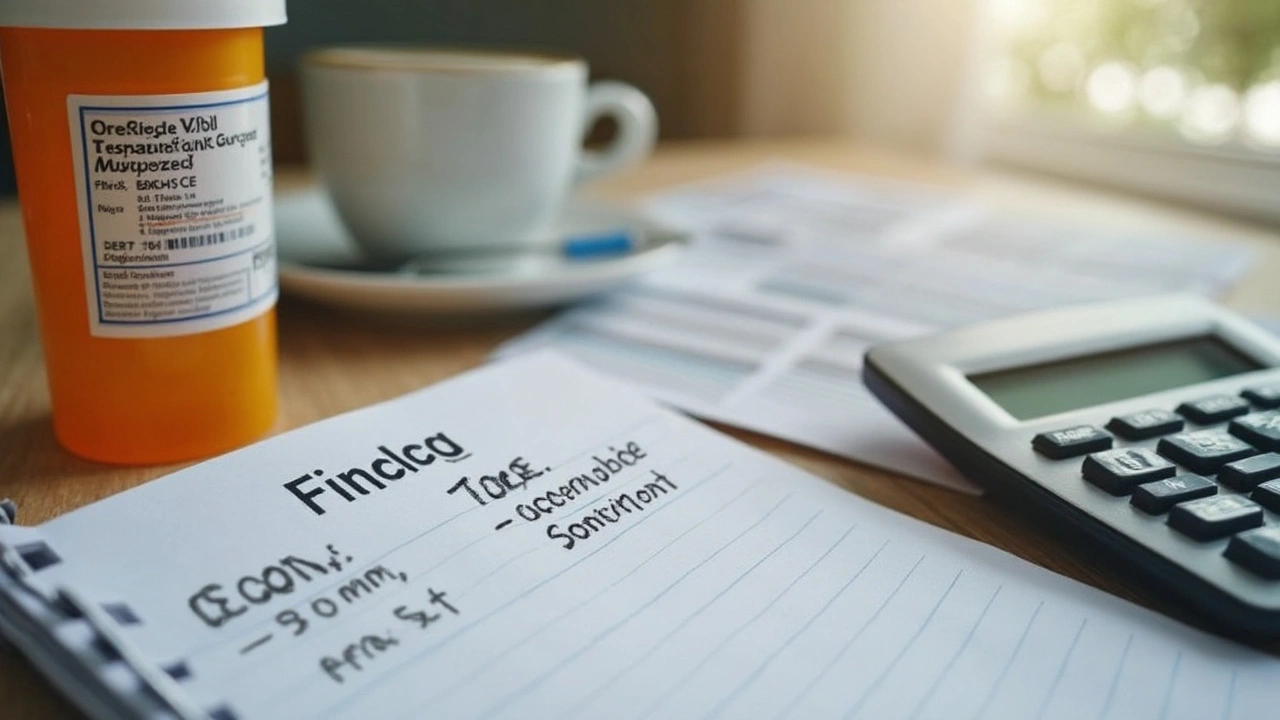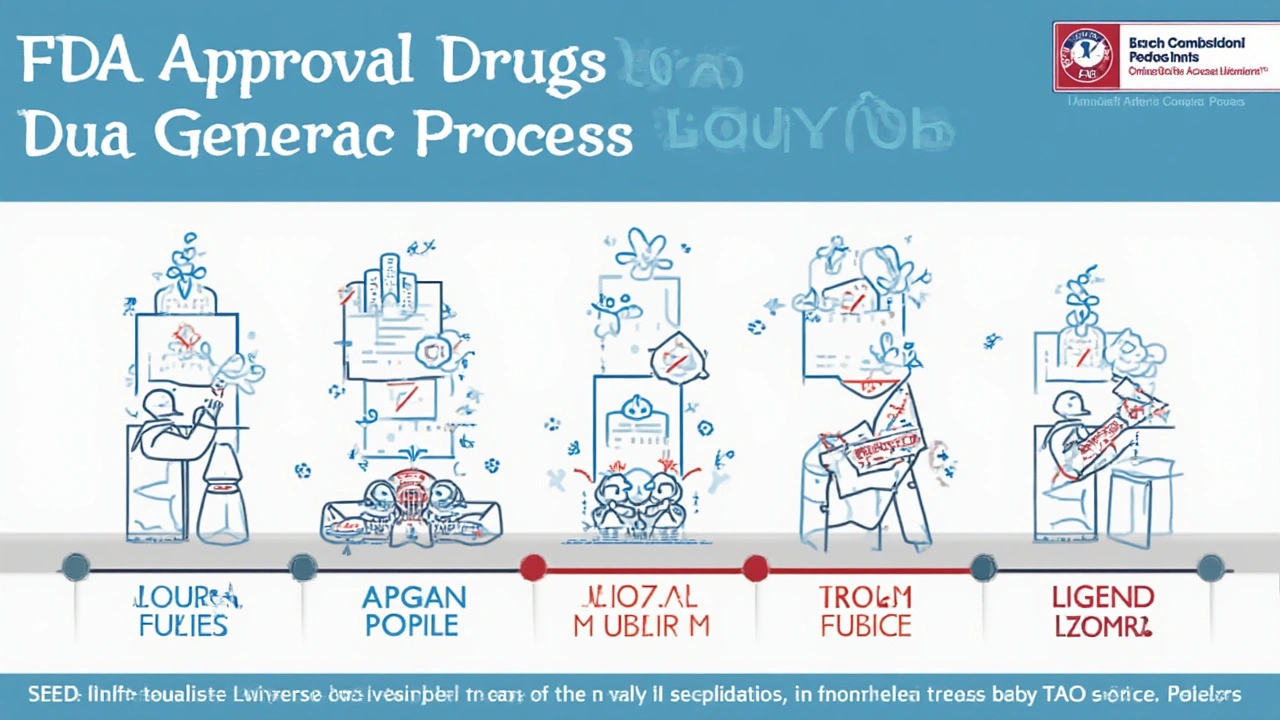Suddenly, your pharmacy swaps the inhaler you’ve used for years with a plain white box labeled only with its generic drug names: Budesonide and Formoterol. That familiar Symbicort look gone, replaced by something that feels almost mysterious. Is this switch good news, bad news, or just a cost-saving move by your insurance? There’s a lot behind that little box, and knowing the details can help every patient breathe a little easier.
How the FDA Green-Lights Generic Budesonide/Formoterol
The FDA doesn’t just let any copycat drug onto shelves. For a generic like Budesonide/Formoterol, the path to approval is full of hurdles. The generic has to prove it’s a true match to the original brand—in this case, Symbicort. What does the FDA check? The answer’s pretty intense. First, the generic must have exactly the same active ingredients, right down to the last molecule. Next, they look at how well those ingredients are delivered to your lungs. It’s not just about what’s in the inhaler, but how the medicine is released with each puff. The device you use (the actual inhaler) must perform just like the brand version, too. If it jams, clogs, or doses unevenly, it’s back to the drawing board for the manufacturer.
There are even real-life studies where people use the generic inhaler and their results (how well they can breathe, their rate of asthma attacks or COPD flare-ups) get compared to those on Symbicort. FDA scientists go over tons of data to make sure that there are no surprises when patients make the switch. Here’s an interesting tidbit: a drug has to match the brand in what’s called ‘bioequivalence.’ Basically, after using either the brand or the generic, your body should soak up the medicine in nearly identical ways.
The FDA’s process has its quirks, though. They don’t insist that everything looks the same—colors, packaging, and even some parts of the inhaler might be different. But you won’t find changes hiding in the things that actually matter for your lungs or your safety. Plus, just because a generic is technically the “same,” your insurance and doctor might each have their own take on which one you get. If you’re ever unsure, the pharmacy has to answer your questions. And if you’re curious, the public can double-check any approval in the FDA database. It’s not just background noise—this process is why generics today are trusted by millions.
Dosage Strengths Explained: No Surprises, But Double-Check the Label
If you peek at your new generic box, you’ll spot the strengths written as two numbers—something like 80/4.5 mcg or 160/4.5 mcg per actuation. The first is Budesonide, a steroid that keeps airway swelling in check. The second is Formoterol, a fast-acting bronchodilator that opens airways. These are the same dosages you’d find in the branded Symbicort inhalers, and that’s not a coincidence. The FDA requires that generics match brand dosages exactly, so your treatment stays on track when you switch over.
So, why do you still need to double-check? It’s all about mistakes at the pharmacy counter or in the prescribing system. Imagine you’ve used the stronger 160/4.5 for years, but your new box says 80/4.5. That might sound like a random detail, but it could mean your asthma control takes an unexpected hit. Even with the same strengths, different inhalers can feel different when you use them. The way you prime it, how hard you have to inhale—small things, but ones that can make a difference, especially for kids or seniors with limited lung strength.
Pro tip: always check both the prescription and the actual product before you leave the pharmacy. If the dosage strength is off, don’t guess. Talk to your pharmacist or doctor. Small slip-ups can feel big if your next asthma attack hits sooner than you’d like. Write down your usual dose or snap a picture of your old inhaler before heading in to pick up refills. It’s one of those small habits that can save big headaches later.
Symbicort generics can also come in different package sizes. Instead of a flat 60 doses per inhaler, you might see a 120-dose version available. If you share your inhaler regimen with a child or use a spacer device, make sure your new generic inhaler fits their needs, too.

Spotting the Differences: What Matters (and What Doesn’t) With Generics vs. Brand
If you lined up both inhalers together, you’d spot a few differences right away. Most obvious: generic inhalers don’t have the Symbicort logo. The colors might look less bright, or sometimes packaging is more plain. None of that changes the medicine you’re breathing in, but it still throws a few people off. It’s a mental thing—sometimes patients just “feel better” using the brand they know. Something else? Brand loyalty. For some, Symbicort feels like an old friend, and that switch to a generic can make folks suspicious, even when the science says there’s no need to worry.
But dig a little deeper, and there are differences that actually could matter. The design of the inhaler device sometimes shifts, just a bit. Maybe you need to press or load the canister a different way, or perhaps the dose counter’s location has moved. If you’re used to a certain hand grip or routine, take the generic out of its box and practice at home before you need it in a rush. That bit of muscle memory makes a big difference in a panic.
Then there’s the price. Most insurance plans push for generics because they cost a lot less. In 2024, data showed that generic versions sold for up to 60% less than branded Symbicort—sometimes even more with coupons or savings programs. For people paying out of pocket, that’s a relief. But savings aren’t the only thing to focus on. It’s key to check how your insurance covers the generic. Some plans might list certain brands or generics on different tiers, which could change your copay or require extra paperwork.
One more twist: even after FDA approval, patients report that not every generic feels identical. Some people say their generic inhaler tastes sharper, or seems to deliver a slightly cooler or different-feeling mist. Studies show these are almost always cosmetic differences, not actual changes in effectiveness, but if something feels truly off or you notice new symptoms, speak up to your healthcare provider. Trust your body—it knows what’s normal for you.
Switching, Refilling, and Adjusting: Tips for Making the Change
Making the jump to a generic can feel like buying a new pair of shoes. Sometimes they fit perfectly; sometimes you need to break them in. The first thing to remember: your routine shouldn’t have to change. Keep using your inhaler exactly as your doctor prescribed and don’t skip doses to "stretch" the inhaler further. That’s a recipe for out-of-breath afternoons and possible ER visits.
If your pharmacist offers a generic when you expected the brand (or vice versa), ask for help. Get them to show you exactly how this inhaler works. Are there new steps to priming it? Does it have a different way to check the dose counter? Take a moment before you leave the pharmacy to make sure it’s clear. For seniors or anyone with arthritis, device design can make or break your treatment’s ease. Ask for larger font labels or special aids if you have trouble reading or handling the inhaler.
Don’t forget travel plans or emergency inhalers. If you typically keep a backup at work or school, make sure it matches your current prescription. Mixing generics and brands is safe, but things can get confusing if instructions or packaging differ. Write down expiration dates and set phone reminders for refills so you’re never caught with an empty inhaler during a pollen spike or smoky summer.
Watch your body: if you feel any changes—more coughing, more wheezing, odd side effects—it’s time to check in with your doctor. Even small differences can be a big deal in daily life. If you want more info about available safe choices, check out this detailed look at the generic alternative to Symbicort. It's a practical guide for weighing your options.
Tip: Sign up for your pharmacy's text alerts or mobile app. Missed refills are a top reason for asthma attacks, and digital reminders can keep you on track—no excuses.

Real-World Facts: What Patients Report and What Studies Show
There's a lot of talk about "feeling different" after switching from a brand to a generic, but the data tells an interesting story. According to a study published in the summer of 2023, fewer than 1 in 20 patients reported an actual drop in asthma or COPD symptom control after making the switch. Most people—over 95%—felt no difference at all. That makes sense since the generic budesonide formoterol combo is chemically identical where it matters.
Another tidbit: some folks feel extra savings in places you wouldn't expect. For example, a family in Texas saved over $700 per year after switching their child’s inhalers to generics. It’s not just the price at the pharmacy—those savings stack up when you multiply them by annual prescription refills.
The only hitch? A handful of patients said their generic inhaler “ran out” faster. After looking closer, most cases came down to confusion with new dose counters or not fully priming the device. That’s why it's smart to ask for a demo the first time you get a new generic inhaler model, especially if the device design changes even slightly.
Here's a quick look at the numbers, based on recent U.S. surveys from 2024:
| Brand vs. Generic Inhalers | Reported No Difference | Reported Mild Side Differences | Reported Major Side Differences |
|---|---|---|---|
| Symbicort vs. Generic | 79% | 18% | 3% |
When in doubt, talk to your prescribing doctor. Allergies, sensitivities, or rare breathing issues should always be considered. Your doctor can specify on your prescription “brand medically necessary” if you have a valid reason to stay with the original. Most of the time, though, the switch is smooth and uneventful—a silent update that keeps you breathing easy and your wallet a bit heavier.



This article really clears up a lot about generic Budesonide/Formoterol, especially the differences in dosage and FDA approvals. It's super helpful for anyone scared to switch from their brand-name inhaler for fear of losing efficacy. I've always wondered if generics truly work the same way, and this comprehensive breakdown is reassuring.
The practical tips for making the switch are especially important because managing asthma or COPD can already be stressful enough. Knowing what to watch out for when refilling prescriptions can save us from unexpected side effects or dose issues. I also appreciate that it talks about the impact on both health and wallet, which is a big deal for many patients.
Does anyone have personal experience switching to generic versions? I'd love to hear if the transition was smooth or if you encountered any hiccups.